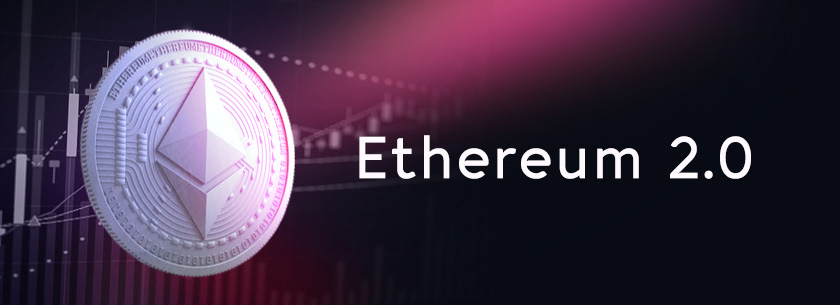
According to the majority of experts, the main events in the world of cryptocurrencies in the near future will be associated not with Bitcoin and its derivatives, but with the Ethereum blockchain. Why? Because if the implementation of the new update succeeds, a lot can change - starting from the traditional approach to cryptocurrency mining, and to the creation of new investment strategies and the more active implementation of crypto in real life. However, not everything is so smooth as we would like.
What is the current situation?
It was officially announced that the Ethereum 2.0 hard fork, aka Metropolis: Constantinople, had to take place on January 16, 2019. However, due to some circumstances, the transition to a new model was delayed until February 28. Nevertheless, everything went well enough to talk about the further development of the entire system. Specifically, another Istanbul hard fork dated December 8, 2019, which provided compatibility of Ethereum with the Zcash cryptocurrency and its planned continuation, Berlin, which is scheduled to take place in 2020.
What is important - Vitalik Buterin himself asked not to call Constantinople a full-fledged hard fork, since this term implied the separation of the network and the creation of new coins, which many scammers immediately tried to use. Therefore, he proposed the use of the phrase “update”. Which, however, did not greatly change the essence of the matter.
In any case, Ethereum 2.0 was created. And it can be argued that it not only corresponded to the declared parameters, but also met the expectations of its creators.
Upcoming updates
The Constantinople update had several primary goals for additional solutions that increased overall performance. They consisted of the following:
- Connecting full POS algorithms - Beacon and Casper.
- Reduction of remuneration for miners (from 3 to 2 ETH 2.0).
- Connecting additional external mechanisms to increase speed - the Plasma and Raiden protocols, which can be considered as analogues of Lightning for the Bitcoin network.
- eWASM for faster code execution.
- Preparing protocols for further integration with zk-snarks, providing evidence with zero disclosure.
- Connection of Bitwise mechanisms, additionally increasing the speed of work.
- Reduce internal network resource demand - Gas.
Switching from POW to POS
This is what, at one time, was declared as the main "chip" of the Ethereum blockchain - the transition to a new consensus algorithm. However, it took a lot of time to collect enough “customer base” for the transition to be possible.
It goes in stages. On the one hand, a reduction in mining rewards will encourage users to switch to other ways to get benefits. On the other, it should be gradual, since a sharp transition can bring down the entire network. And the fewer users support the protocol, the higher the chance to carry out an attack of 51 percent, which would finally destroy the reputation of this blockchain.
So for a while, ordinary miners “coexisted” with “validator holders”. To become them, however, some efforts need to be made.
For start, get a minimum of 32 ETH 2.0 at current market value. Then - “fix” this amount on your virtual wallet, create a “validator node” with annual maintenance of $ 120 (for each node) or $ 60 (for each client), normal processing power and a channel with good conductivity. However, these costs are offset by the internal mechanisms of the network and the receipt of remuneration. In addition, you need to be prepared for the fact that you won’t be able to immediately withdraw the fixed amount - you need at least 18 hours to unlock it.
From the list of validators, a certain number of machines is selected in a pseudo-random manner - the “committee”, which makes the decision on validating transactions and confirming new blocks.
Validators annual profit is calculated according to the formula: basic fee + network fees - those 120 dollars that were spent on launching the site. It directly depends on the number of participants and the level of competition between them. So, for example, with a total amount of 1 million ETH fixed on the accounts of validators, each participant will receive an annual yield of 18.10 percent. As the amount increases, however, the yield will decline.
There are also other factors that reduce this same profitability:
- A large number of offline or temporarily disabled validator nodes
- Removing validators due to attempts to break network rules
- Increasing of transaction costs
- Excessive use of the internal resource - Gas, in order to reduce the commission.
Existing flaws
Despite an active improvement, Ethereum 2.0 still had flaws that are planned to be removed in future updates:
- Scalability. The eternal blockchain issue that Ethereum faced at the current moment. After all, the more actively the network capabilities are used, the slower the process goes. And for many DApps, speed is a critical factor.
- Bomb of difficulty. A complete rejection of PoW in favor of PoS is impossible without a massive overhaul of the familiar system. So far, it is being carried out by gradually complicating mining, but this process also has a limit.
- Safety. It is never too much - as evidenced by a variety of successful hacker attacks and the use of vulnerabilities in smart contracts and protocols.
Conclusions
Hard fork ethereum 2.0 allowed to solve quite a few problems associated with the network, and give the way for further updates - the Serenity protocol and all possible subsequent ones. The result was effective enough to be actively used in practice and to contribute to the further integration of decentralized applications and cryptocurrencies into the lives of ordinary people. However, the situation can be significantly improved - and experts are actively working on it. In general, forecasts about the fate of Ethereum are positive.




